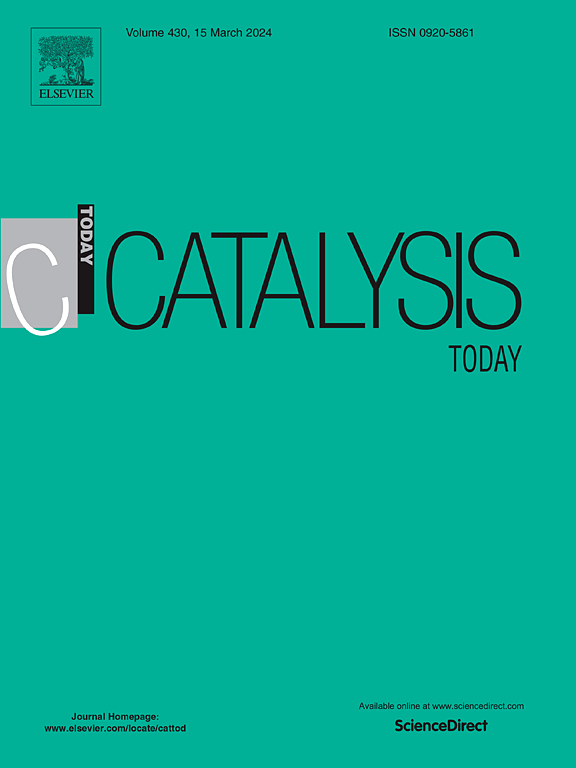Doped CeO2-LaFeO3 composite cathode for high-temperature CO2 electrolysis: Improved performance and H2S tolerance
IF 5.2
2区 化学
Q1 CHEMISTRY, APPLIED
引用次数: 0
Abstract
High-temperature solid oxide electrolysis cells (SOECs) are a promising solution for CO2 reutilization, however traditional Ni-based cathodes face challenges for high activity and stability by carbon deposition as well as sulfur poisoning. This study examines the CO2 electrolysis performance and H2S tolerance of a perovskite and fluorite composite cathode, Ce0.6Mn0.3Fe0.1O2-La0.6Sr0.4Fe0.8Mn0.2O3 (CMF-LSFM), using a 0.3 mm thickness LSGM electrolyte. The composite showed synergy effect and achieved a current density a nearly double larger than that of pure LSFM or CMF cathode at 1073 K and 1.6 V, with Faraday efficiency of ca. 100 % and negligible carbon deposition. At 1173 K, the composite achieved a current density as high as 1.2 A/cm2 at 1.6 V. H2S tolerance tests showed the electrode endured 3 ppm H2S with recoverable deactivation, however further higher concentrations (10–30 ppm) caused cathodic activity to decrease slightly, which was much stable than that of Ni. The degradation is mainly attributed to Sr segregation and the formation of surface sulfate species (SO42-), which block active sites. These results showed CMF-LSFM as a high-performance cathode for CO2 electrolysis with reasonable stability to H2S.
用于高温CO2电解的掺杂CeO2-LaFeO3复合阴极:提高了性能和H2S耐受性
高温固体氧化物电解电池(soec)是一种很有前途的二氧化碳再利用解决方案,但传统的镍基阴极面临着碳沉积和硫中毒的高活性和稳定性挑战。本研究使用0.3 mm厚度的LSGM电解液,考察了钙钛矿和荧石复合阴极ce0.6 mn0.3 fe0.1 o02 - la0.6 sr0.4 fe0.8 mn0.2o3 (CMF-LSFM)的CO2电解性能和H2S耐受性。在1073 K和1.6 V下,复合材料表现出协同效应,电流密度几乎是纯LSFM或CMF阴极的两倍,法拉第效率约为100% %,碳沉积可以忽略不计。在1173 K下,该复合材料在1.6 V下的电流密度高达1.2 a /cm2。H2S耐受性测试表明,电极承受3 ppm H2S可恢复失活,但浓度进一步升高(10-30 ppm)会导致阴极活性略有下降,但比Ni稳定得多。降解主要是由于Sr偏析和表面硫酸盐(SO42-)的形成,从而阻断活性位点。这些结果表明,CMF-LSFM是一种高性能的CO2电解阴极,对H2S具有一定的稳定性。
本文章由计算机程序翻译,如有差异,请以英文原文为准。
求助全文
约1分钟内获得全文
求助全文
来源期刊

Catalysis Today
化学-工程:化工
CiteScore
11.50
自引率
3.80%
发文量
573
审稿时长
2.9 months
期刊介绍:
Catalysis Today focuses on the rapid publication of original invited papers devoted to currently important topics in catalysis and related subjects. The journal only publishes special issues (Proposing a Catalysis Today Special Issue), each of which is supervised by Guest Editors who recruit individual papers and oversee the peer review process. Catalysis Today offers researchers in the field of catalysis in-depth overviews of topical issues.
Both fundamental and applied aspects of catalysis are covered. Subjects such as catalysis of immobilized organometallic and biocatalytic systems are welcome. Subjects related to catalysis such as experimental techniques, adsorption, process technology, synthesis, in situ characterization, computational, theoretical modeling, imaging and others are included if there is a clear relationship to catalysis.
 求助内容:
求助内容: 应助结果提醒方式:
应助结果提醒方式:


